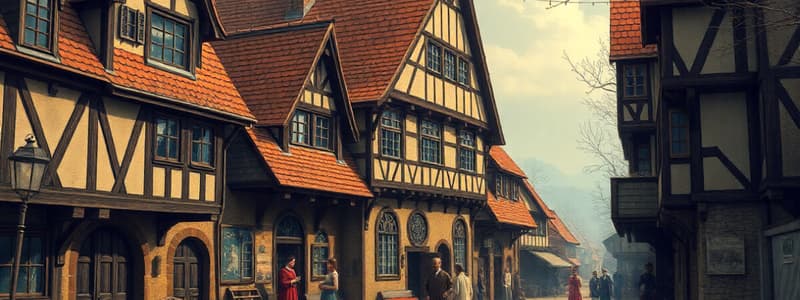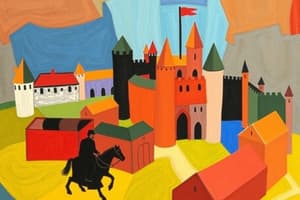Podcast
Questions and Answers
Widespread peasant rebellions in the 14th century, such as the 1381 English peasant revolt, challenged _______.
Widespread peasant rebellions in the 14th century, such as the 1381 English peasant revolt, challenged _______.
feudalism
The transition from feudalism to _______ involved three crucial moments according to Maurice Dobb.
The transition from feudalism to _______ involved three crucial moments according to Maurice Dobb.
capitalism
The rise of absolutist _______ gained power as feudalism declined and national identity grew.
The rise of absolutist _______ gained power as feudalism declined and national identity grew.
monarchies
Despite setbacks, peasant rebellions forced feudal landowners to consider _______ that ultimately led to serfdom's demise.
Despite setbacks, peasant rebellions forced feudal landowners to consider _______ that ultimately led to serfdom's demise.
The _______ of capitalism through the Industrial Revolution occurred in the 18th and 19th centuries.
The _______ of capitalism through the Industrial Revolution occurred in the 18th and 19th centuries.
The shift from feudalism to capitalism involved a change in exploitation, moving from _______ to capitalist exploitation.
The shift from feudalism to capitalism involved a change in exploitation, moving from _______ to capitalist exploitation.
Nationalism and loyalty to the state grew during the _______.
Nationalism and loyalty to the state grew during the _______.
Feudalism is defined as a system where producers are forced to fulfill economic demands of an overlord through ______ or dues.
Feudalism is defined as a system where producers are forced to fulfill economic demands of an overlord through ______ or dues.
During feudalism, lords held almost total control over ______, with minimal legal limitations.
During feudalism, lords held almost total control over ______, with minimal legal limitations.
Feudalism began to decline in Western Europe around the ______-14th centuries.
Feudalism began to decline in Western Europe around the ______-14th centuries.
The ______ introduced new military technologies like gunpowder, which weakened feudal castles.
The ______ introduced new military technologies like gunpowder, which weakened feudal castles.
The growth of cities during the decline of feudalism offered refuge to serfs seeking ______ from feudal oppression.
The growth of cities during the decline of feudalism offered refuge to serfs seeking ______ from feudal oppression.
The Black Death led to a decrease in ______ as peasants gained more bargaining power.
The Black Death led to a decrease in ______ as peasants gained more bargaining power.
The Hundred Years' War increased the use of longbows and cannons, weakening feudal ______.
The Hundred Years' War increased the use of longbows and cannons, weakening feudal ______.
Bailiffs often accumulated wealth through trade, leading to the renting of lands from feudal ______.
Bailiffs often accumulated wealth through trade, leading to the renting of lands from feudal ______.
Flashcards
Feudalism
Feudalism
A system where producers (serfs) are forced to serve an overlord through labor or dues, characterized by primitive production, limited division of labor, and demesne farming.
Demesne Farming
Demesne Farming
A type of agricultural production within feudalism where the majority of the produce is used to sustain the lord and his household.
Decentralized Power
Decentralized Power
In feudalism, monarchs held ultimate power, but feudals maintained significant control over their own lands and subjects.
Crusades and Feudalism
Crusades and Feudalism
Signup and view all the flashcards
Growth of Cities and Feudalism
Growth of Cities and Feudalism
Signup and view all the flashcards
Transformation of the Manor System
Transformation of the Manor System
Signup and view all the flashcards
Black Death and Feudalism
Black Death and Feudalism
Signup and view all the flashcards
Hundred Years' War and Feudalism
Hundred Years' War and Feudalism
Signup and view all the flashcards
Peasant Rebellions
Peasant Rebellions
Signup and view all the flashcards
Impact of Peasant Rebellions
Impact of Peasant Rebellions
Signup and view all the flashcards
Rise of Absolutist Monarchies
Rise of Absolutist Monarchies
Signup and view all the flashcards
Role of Feudal Aristocracy
Role of Feudal Aristocracy
Signup and view all the flashcards
Transition from Feudalism to Capitalism
Transition from Feudalism to Capitalism
Signup and view all the flashcards
Consequences of Transition
Consequences of Transition
Signup and view all the flashcards
Maurice Dobb's Three Moments
Maurice Dobb's Three Moments
Signup and view all the flashcards
Study Notes
Feudalism: A System of Serfdom and Exploitation
- Defined by historian Maurice Dobb as a system where producers are forced to fulfill economic demands of an overlord through services or dues.
- Characterized by primitive production techniques, unsophisticated division of labor, and demesne farming, where most produce was used for the lord's needs.
- Lords held almost total control over serfs, with minimal legal limitations.
- Feudalism was politically decentralized, with monarchs as de facto sovereigns, but feudals maintained significant control over their lands.
The Decline of Feudalism in Western Europe
- Began around the 13th-14th centuries, with capitalism emerging as a more profitable mode of production.
- Monarchs sought to increase control over the state and its feudal subjects, supported by a rising class of urban capitalists.
Factors Contributing to the Decline of Feudalism
-
The Crusades:
- Feudal lords often used their resources to raise armies for the Crusades.
- Returning lords often faced financial hardship, sometimes selling lands to peasants, freeing some from feudal control.
- The Crusades introduced new military technologies like gunpowder, weakening feudal castles and strengthening monarchical power.
- Crusader expansion of trade restored long-distance trade routes and stimulated economic growth in Western Europe.
-
The Growth of Cities:
- Offered refuge to serfs seeking freedom from feudal oppression and provided employment opportunities.
- Attracted peasants as a cheap labor force and soldiers for city-based militias.
- While urban population remained relatively small (10% of Europe), the existence of cities pressured feudal landowners.
-
Transformation of the Manor System:
- Feudal lords appointed bailiffs to manage their lands.
- Bailiffs often accumulated wealth through trade, leading to land rental from feudal lords.
- These capitalist farmers employed peasants for wages, marking the emergence of capitalist relations in the countryside.
-
The Black Death:
- The Black Death (14th century) devastated Europe, killing 24 million to 70 million people.
- It led to labor shortages and a decrease in serfdom as peasants gained more bargaining power.
-
The Hundred Years' War:
- Increased the use of longbows and cannons, weakening feudal armies and strengthening monarchies.
- Led to the creation of standing armies composed of commoners, further eroding feudal dependence.
- Nationalism and loyalty to the state grew during the war, furthering the shift in power.
-
Social Unrest and Peasant Rebellions:
- Widespread peasant rebellions in the 14th century, including the 1381 English peasant revolt, challenged feudalism.
- These rebellions, despite setbacks, prompted feudal landowners to consider change, ultimately contributing to the demise of serfdom.
-
The Rise of Absolutist Monarchies:
- Monarchs gained power through the decline of feudalism and the growth of national identity.
- They expanded their control over territory and strengthened central government.
- Feudal aristocracy retained some political influence but gradually lost economic power to the bourgeoisie.
The Transition from Feudalism to Capitalism
- A lengthy process spanning centuries, characterized by economic crises and social upheavals.
- According to Maurice Dobb, the transition involved three crucial moments:
- The crisis of feudalism in the 14th century.
- The emergence of capitalism in the late 16th and 17th centuries.
- The victory of capitalism through the Industrial Revolution in the 18th and 19th centuries.
- The shift from feudalism to capitalism brought a change in exploitation, moving from feudal to capitalist exploitation, but also resulted in advancements for humanity in terms of civil and political rights.
Studying That Suits You
Use AI to generate personalized quizzes and flashcards to suit your learning preferences.




